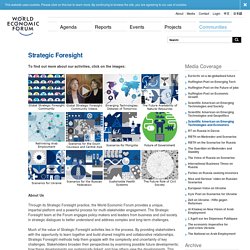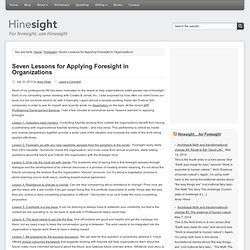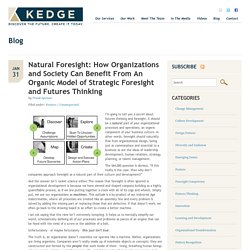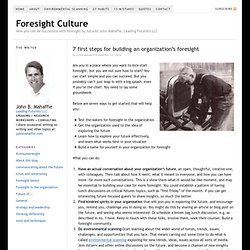

World Economic Forum - Strategic Foresight. To find out more about our activities, click on the images: About Us Through its Strategic Foresight practice, the World Economic Forum provides a unique, impartial platform and a powerful process for multi-stakeholder engagement.

The Strategic Foresight team at the Forum engages policy-makers and leaders from business and civil society in strategic dialogues to better understand and address complex and long-term challenges. Much of the value of Strategic Foresight activities lies in the process. By providing stakeholders with the opportunity to learn together and build shared insights and collaborative relationships, Strategic Foresight methods help them grapple with the complexity and uncertainty of key challenges. The Forum has developed its own world-class methodology using a mixture of tools, including: Scenarios – Plausible, coherent stories about the future aimed at making sense of uncertain issues, and clarifying strategic options for decision-makers. Contacts: World Economic Forum - Global Agenda Council on the Future of Government 2012-2014.
“Governments are realizing that technology can act as an enabler to transform government processes, enhancing the provision of public services and enabling higher productivity.”

The challenge The digital revolution is transforming politics and the nature of government. From education improvement and tax collection to better healthcare systems and job creation, technology is putting pressure on governments to deliver more with less. Citizens’ voices are increasingly present in public policy-making processes, and their demands for an “always-on”, connected government are intensifying through social media. Governments are realizing that technology can act as an enabler to transform government processes, enhancing the provision of public services and enabling higher productivity. What the Council is doing about it The Council is set to produce the Future of Government Smart Toolbox. The toolbox will have its global launch at the UAE Government Summit on 10 June 2014. To get involved, contact: Seven Lessons for Applying Foresight in Organizations.
Much of my professional life has been motivated by the desire to help organizations make greater use of foresight.

Early in my consulting career, working with Coates & Jarratt, Inc., I was surprised by how often our client loved our work, but did not know what to do with it internally. I spent almost a decade working inside two Fortune 500 companies in order to see for myself, and recently wrote my dissertation on the topic. At the recent APF Professional Development Seminar, I had a few minutes to summarize some “lessons learned” in applying foresight. Lesson 1. Outsiders need insiders. Lesson 2. Lesson 3.
Lesson 4. Lesson 5. Lesson 6. Lesson 7. Of course, you need not accept these lessons, but may respond in the spirit of working toward shared meaning Andy Hines. Natural Foresight: How Organizations and Society Can Benefit From An Organic Model of Strategic Foresight and Futures Thinking - Kedge. I’m going to tell you a secret about futures thinking and foresight: It should be a natural part of your organizational processes and operations, an organic component of your business culture.

In other words, foresight should naturally flow from organizational design, being just as commonplace and essential to a business as are the ideas of leadership development, human relations, strategy, planning, or talent management. The $64,000 question is obvious, “If this really is the case, then why don’t companies approach foresight as a natural part of their culture and development?” And the answer isn’t rocket science either. The reason that foresight is often ignored in organizational development is because we have viewed and shaped company-building as a highly quantifiable process, as if we are putting together a clock with all of its cogs and wheels. Simply put, we see our organizations as machines. I am not saying that this view isn’t extremely tempting.
The answer is, you don’t. P.S. How Researchers Map The Future Of Innovation. This article is part of ReadWrite Future Tech, an annual series where we explore how technologies that will shape our lives in the years and decades to come are grounded in the innovation and research of today.

In 1991, the United States Defense Advanced Research Project Agency, the research arm of the Pentagon, reorganized its priorities. Part of that reorganization meant much of the funding the agency had provided for projects like artificial intelligence and deep neural networks was pulled. It may have been the best and worst thing to ever happen to the field of artificial intelligence. Peter Lee, the corporate vice president for Microsoft Research, describes the time after DARPA’s 1991 reorganization as the “AI Winter.” 7 first steps for building an organization’s foresight. Are you in a place where you want to kick-start foresight, but you are not sure how to start?

You can start simple and you can succeed. But you probably can’t just leap in with a big splash, even if you’re the chief. You need to lay some groundwork. Below are seven ways to get started that will help you: